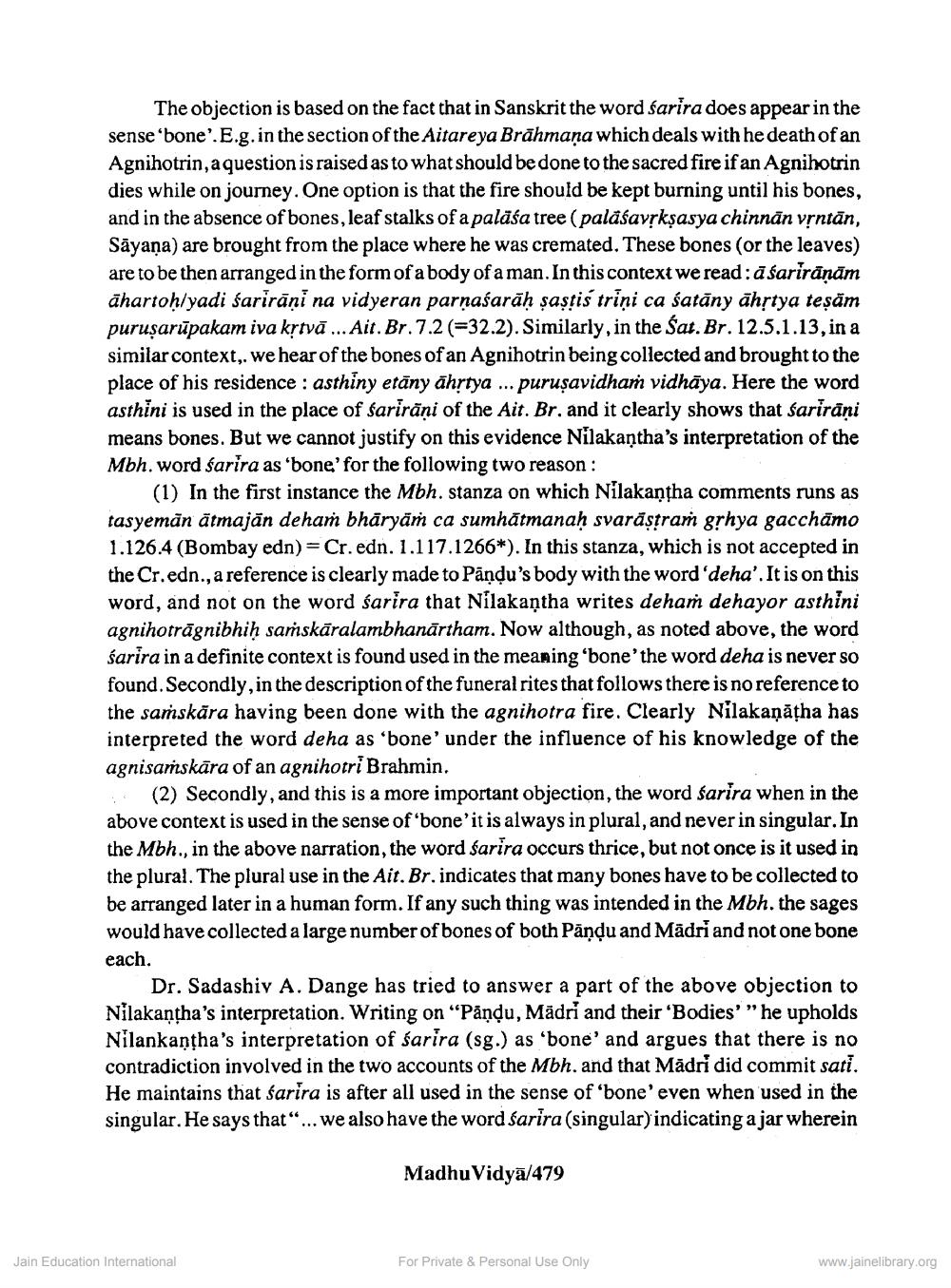________________
The objection is based on the fact that in Sanskrit the word śarira does appear in the sense bone'.E.g. in the section of the Aitareya Brāhmaṇa which deals with he death of an Agnihotrin, a question is raised as to what should be done to the sacred fire if an Agnihotrin dies while on journey. One option is that the fire should be kept burning until his bones, and in the absence of bones, leaf stalks of a palāśa tree (palāśavşkşasya chinnän vrntān, Sāyana) are brought from the place where he was cremated. These bones (or the leaves) are to be then arranged in the form of a body of a man. In this context we read:āśarirānām āhartoh/yadi sarirani na vidyeran parnasarāḥ şaştis triņi ca satāny áhrtya teşām purusarūpakam iva krtvā ... Ait. Br. 7.2 (=32.2). Similarly, in the Sat. Br. 12.5.1.13, in a similar context, we hear of the bones of an Agnihotrin being collected and brought to the place of his residence : asthiny etāny áhrtya ... puruşavidhaṁ vidhāya. Here the word asthini is used in the place of barirāni of the Ait. Br. and it clearly shows that sarirani means bones. But we cannot justify on this evidence Nilakantha's interpretation of the Mbh. word sarira as 'bone' for the following two reason :
(1) In the first instance the Moh. stanza on which Nilakantha comments runs as tasyemān ātmajān deham bhāryāṁ ca sumhātmanaḥ svarăstram grhya gacchāmo 1.126.4 (Bombay edn) = Cr.edn. 1.117.1266*). In this stanza, which is not accepted in the Cr.edn., a reference is clearly made to Pāndu's body with the word deha'. It is on this word, and not on the word śarira that Nilakantha writes deham dehayor asthini agnihotrāgnibhiḥ saṁskāralambhanārtham. Now although, as noted above, the word śarira in a definite context is found used in the meaning 'bone'the word deha is never so found. Secondly, in the description of the funeral rites that follows there is no reference to the saṁskāra having been done with the agnihotra fire. Clearly Nilakaņāțha has interpreted the word deha as 'bone' under the influence of his knowledge of the agnisarskāra of an agnihotri Brahmin.
(2) Secondly, and this is a more important objection, the word śarira when in the above context is used in the sense of bone'it is always in plural, and never in singular. In the Mbh., in the above narration, the word sarira occurs thrice, but not once is it used in the plural. The plural use in the Ait.Br. indicates that many bones have to be collected to be arranged later in a human form. If any such thing was intended in the Mbh. the sages would have collected a large number of bones of both Pāņdu and Mādri and not one bone each.
Dr. Sadashiv A. Dange has tried to answer a part of the above objection to Nilakantha's interpretation. Writing on “Pānļu, Mädri and their 'Bodies'" he upholds Nilankantha's interpretation of sarira (sg.) as 'bone' and argues that there is no contradiction involved in the two accounts of the Mbh. and that Mădri did commit sati. He maintains that śarira is after all used in the sense of bone'even when used in the singular. He says that“...we also have the word śarira(singular) indicating a jar wherein
MadhuVidyā/479
Jain Education International
For Private & Personal Use Only
www.jainelibrary.org




